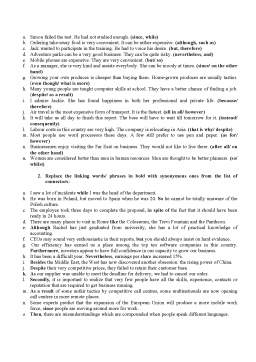Cuprins
- I. Organizing compositions
- II. Connecting paragraphs
- III. Connecting sentences
- IV. Cohesive devises
- V. Activities
Extras din curs
I. ORGANIZING COMPOSITIONS
The layout of most types of writing consists of three parts: an introduction, a main body and a conclusion.
I. Introduction
The introduction, i.e. the first paragraph, is a short paragraph whose purpose is to give the reader a general idea of the subject of the composition. It should attract the reader’s attention so that he/ she wants to continue reading.
II. Main body
The main body usually consists of two or more paragraphs and its purpose is to develop points related to the subject of the composition. The number of paragraphs and the way you divide them depends on the specific topics of the composition. Each paragraph should deal with points related to the same topic. Whenever you discuss a new topic, you should begin a new paragraph.
III. Conclusion
The conclusion is a short final paragraph in which you can summarize the main idea of the subject, restate your opinion in different words, make general comments, express your feelings etc.
II. CONNECTING PARAGRAPHS
Your ideas should be organized into paragraphs.
III. CONNECTING SENTENCES
Paragraphs comprise sentences which are organized according to certain principles.
Main body paragraphs should always start with a topic sentence. This topic sentence introduces or summarizes the main topic of the paragraph and gives the reader an idea of what the paragraph will be about.
Topic sentences should be followed by supporting sentences which provide examples, details, reasons, justifications and/ or evidence to support the topic sentence.
IV. COHESIVE DEVISES
Cohesive devices are means by which parts of the text are linked as logically related sequences. They signal the relationship between ideas in such a way that the writer’s intentions are made clear. They make obvious the developing thread of meaning, which the writer is trying to communicate and often help us to anticipate what is coming next. These links include a variety of devices such as the use of pronouns, articles, conjunctions, demonstratives, prepositional phrases, synonyms and repetition of key words.
List of connectors
a. ENUMERATION indicates a cataloguing of what is being said. Some enumerations belong to clearly defined sets:
• first, … → furthermost, … → finally,…
• one, … → two, ….. → three, …→ etc.
• first(ly), …. → second(ly), … → third(ly), …. → etc.
• to begin/ start with, …→ in the second place, …. / moreover, …/ next, …/ then, …/ afterward, … → lastly, …/ finally, …/ to conclude, …
• above all/ last but not least: mark the end of an ascending order
• first and foremost/ first and most important(ly): mark the beginning of a descending order
b. ADDITION adds something to what has been previously indicated. It includes:
a. Reinforcement: also/ again/ furthermore/ further/ moreover/ what is more/ then/ in addition/ besides/ above all/ too/ as well as
b. Equation: equally/ likewise/ similarly/ correspondingly/ in the same way
From the point of view of meaning, there could also be negative equivalents of “and”: neither…nor…
c. TRANSITION can lead to a new stage in the sequence of thought.
a. now/ with reference to/ with respect to/ with regard to/ regarding/ let us turn to/ as for/ as to
b. talking/ speaking of/ apropos/ that reminds me of: introduce a digression
c. incidentally/ by the way/ come to think of it: indicate a digression and an afterthought
d. SUMMATION indicates a generalization or summing-up of what has preceded: in conclusion/ to conclude/ to sum up briefly/ in brief/ to summarize/ altogether/ overall/ then/ therefore/ thus.
e. APPOSITION is used to refer back to previous sentences or to parallel or related references: i.e./ that is/ that is to say/ namely/ in other words/ or/ or rather/ or better/ e.g./ for example/ for instance/ such as/ including
f. RESULT expresses the consequence or result of what was said before: so/ therefore/ as a result/ as a consequence/ the result was…/ the consequence was…/ accordingly/ consequently/ because of this/ thus/ hence/ for this reason/ for that reason
g. INFERENCE indicates a deduction from what is implicit in the preceding sentence(s): then/ in other words/ in that case/ if so/ if not/ that implies/ my conclusion is/ else/ otherwise
h. REPLACEMENT expresses an alternative to what has preceded: again/ alternatively/ rather/ better/ worse/ on the other hand/ the alternative is/ another possibility would be
Preview document
Conținut arhivă zip
- Organizing a Written Text.doc













